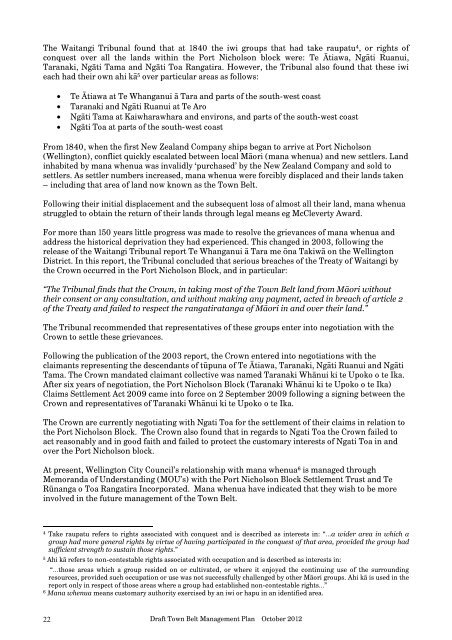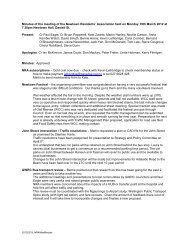Draft Town Belt Management Plan - Wellington City Council
Draft Town Belt Management Plan - Wellington City Council
Draft Town Belt Management Plan - Wellington City Council
Create successful ePaper yourself
Turn your PDF publications into a flip-book with our unique Google optimized e-Paper software.
The Waitangi Tribunal found that at 1840 the iwi groups that had take raupatu 4 , or rights of<br />
conquest over all the lands within the Port Nicholson block were: Te Ātiawa, Ngāti Ruanui,<br />
Taranaki, Ngāti Tama and Ngāti Toa Rangatira. However, the Tribunal also found that these iwi<br />
each had their own ahi kā 5 over particular areas as follows:<br />
22<br />
• Te Ātiawa at Te Whanganui ā Tara and parts of the south-west coast<br />
• Taranaki and Ngāti Ruanui at Te Aro<br />
• Ngāti Tama at Kaiwharawhara and environs, and parts of the south-west coast<br />
• Ngāti Toa at parts of the south-west coast<br />
From 1840, when the first New Zealand Company ships began to arrive at Port Nicholson<br />
(<strong>Wellington</strong>), conflict quickly escalated between local Māori (mana whenua) and new settlers. Land<br />
inhabited by mana whenua was invalidly ‘purchased’ by the New Zealand Company and sold to<br />
settlers. As settler numbers increased, mana whenua were forcibly displaced and their lands taken<br />
– including that area of land now known as the <strong>Town</strong> <strong>Belt</strong>.<br />
Following their initial displacement and the subsequent loss of almost all their land, mana whenua<br />
struggled to obtain the return of their lands through legal means eg McCleverty Award.<br />
For more than 150 years little progress was made to resolve the grievances of mana whenua and<br />
address the historical deprivation they had experienced. This changed in 2003, following the<br />
release of the Waitangi Tribunal report Te Whanganui ā Tara me ōna Takiwā on the <strong>Wellington</strong><br />
District. In this report, the Tribunal concluded that serious breaches of the Treaty of Waitangi by<br />
the Crown occurred in the Port Nicholson Block, and in particular:<br />
“The Tribunal finds that the Crown, in taking most of the <strong>Town</strong> <strong>Belt</strong> land from Māori without<br />
their consent or any consultation, and without making any payment, acted in breach of article 2<br />
of the Treaty and failed to respect the rangatiratanga of Māori in and over their land.”<br />
The Tribunal recommended that representatives of these groups enter into negotiation with the<br />
Crown to settle these grievances.<br />
Following the publication of the 2003 report, the Crown entered into negotiations with the<br />
claimants representing the descendants of tūpuna of Te Ātiawa, Taranaki, Ngāti Ruanui and Ngāti<br />
Tama. The Crown mandated claimant collective was named Taranaki Whānui ki te Upoko o te Ika.<br />
After six years of negotiation, the Port Nicholson Block (Taranaki Whānui ki te Upoko o te Ika)<br />
Claims Settlement Act 2009 came into force on 2 September 2009 following a signing between the<br />
Crown and representatives of Taranaki Whānui ki te Upoko o te Ika.<br />
The Crown are currently negotiating with Ngati Toa for the settlement of their claims in relation to<br />
the Port Nicholson Block. The Crown also found that in regards to Ngati Toa the Crown failed to<br />
act reasonably and in good faith and failed to protect the customary interests of Ngati Toa in and<br />
over the Port Nicholson block.<br />
At present, <strong>Wellington</strong> <strong>City</strong> <strong>Council</strong>’s relationship with mana whenua 6 is managed through<br />
Memoranda of Understanding (MOU’s) with the Port Nicholson Block Settlement Trust and Te<br />
Rūnanga o Toa Rangatira Incorporated. Mana whenua have indicated that they wish to be more<br />
involved in the future management of the <strong>Town</strong> <strong>Belt</strong>.<br />
4 Take raupatu refers to rights associated with conquest and is described as interests in: “…a wider area in which a<br />
group had more general rights by virtue of having participated in the conquest of that area, provided the group had<br />
sufficient strength to sustain those rights.”<br />
5 Ahi kā refers to non-contestable rights associated with occupation and is described as interests in:<br />
“…those areas which a group resided on or cultivated, or where it enjoyed the continuing use of the surrounding<br />
resources, provided such occupation or use was not successfully challenged by other Māori groups. Ahi kā is used in the<br />
report only in respect of those areas where a group had established non-contestable rights…”<br />
6 Mana whenua means customary authority exercised by an iwi or hapu in an identified area.<br />
<strong>Draft</strong> <strong>Town</strong> <strong>Belt</strong> <strong>Management</strong> <strong>Plan</strong> October 2012





